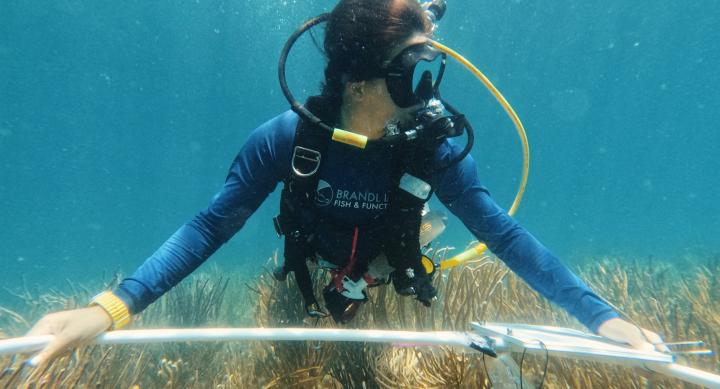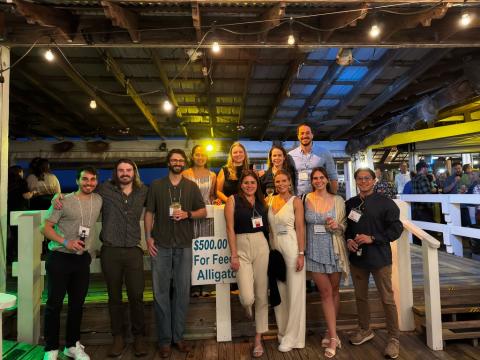
Hidden in the crevices of tropical ocean reefs are tiny flecks of color darting in and out of the corals. These are cryptobenthic fish—“crypto” meaning “hidden” and “benthic” meaning “on the bottom”—known for their elusive nature.
Measuring fewer than five centimeters long, these fish are small enough for hundreds to fit in your hands. Each weighs about as much as a single pea.
Cryptobenthic fish are known for their short lifespans, rapid reproductive cycles and preference for specific microhabitats within the larger coral reef. But these tiny, under-researched fish answer a key question that has long left scientists scratching their heads: How did coral reefs become the most biologically diverse marine ecosystems?
Fourth-year Ph.D. candidate Mariana Rivera-Higueras is diving deeper at The University of Texas at Austin Marine Science Institute (UTMSI) in Port Aransas. She is the first to describe the cryptobenthic fish community in the southwest reef systems of the Gulf near her hometown of Veracruz, Mexico, and the first to compare cryptobenthic fish communities in the Caribbean.
“Coral reefs are being threatened by both climate change and anthropogenic impacts,” Rivera-Higueras says. “We know these ecosystems harbor great biodiversity and we depend on them in different ways. In my research work, I focus on understanding how biodiversity is maintained, originates and declines in coral reefs. The cryptobenthic fish community is an ideal and accessible model for predicting reef composition over time and how this composition impacts biodiversity.”

Hidden Gems of the Reef
Though Rivera-Higueras grew up around the Gulf, she was always terrified of the ocean, only ever going into the water up to her knees. Now, she feels at home swimming along the ocean floor.
“Once I get into the water, I become part of the reef,” Rivera-Higueras says. “When you get into that peaceful place, there is nothing better than diving. I just don’t want to go."
Rivera-Higueras first encountered cryptobenthics during her master’s thesis at Universidad Nacional Autónoma de México (UNAM), where she studied invasive lionfish in the coral reef system of Veracruz. One day in the lab, she discovered a plethora of tiny fish she was unable to identify—in the belly of a lionfish. On her next diving expedition, Rivera-Higueras swam closer to the sea floor and found a flurry of the same fish in all different species, sizes and colors.
“I got super curious about them and obsessed—I was trying to take photos of them because they were too tiny to admire their details with the naked eye,” Rivera-Higueras says. “I wanted more information and realized there was not much knowledge about them. They are still an undescribed group in many places.”
Supported by fellowships from the Smithsonian Tropical Research Institute and ConTex, Rivera-Higueras joined UT’s doctoral program in marine ecology to study under Assistant Professor Simon Brandl. Brandl leads a team of students at the Fish and Functions Lab in Port Aransas. His team focuses in part on the marine biodiversity of cryptobenthic coral reef fishes and the interrelated ecological processes governing tropical coral reef ecosystems. Through this research, they hope to shed light on the evolution of coral reef biodiversity, and the ways biodiversity is threatened by human impacts.
“Mariana’s research tackles a foundational question in ecology: why do some species occur in one place, but not in another?” Brandl says. “By focusing on a tractable and exciting study system—communities of tiny, bottom-dwelling coral reef fishes in the Caribbean and Gulf of Mexico—her work explores an exciting frontier that has already led to interesting discoveries.”
Diving Deeper
Rivera-Higueras has traveled to sites in Veracruz, Panama and Belize to conduct her fieldwork. There, she samples cryptobenthics from different microhabitats within the coral reefs, such as sea grass, gorgoniids, caves and in both live and dead coral—meaning she is underwater from around 8 a.m. to 3 p.m. every day.
“It’s very intense, because we work against the clock, especially because the weather can change and you don’t know if the conditions will let you go,” Rivera-Higueras says. “One day lost...it hurts.”
When she dives down to her sample site on the ocean floor, Rivera-Higueras sets a modified umbrella net over an elevated area of a coral reef crop. She covers the net with a tarp, used to protect creatures outside the net from a clove-oil solution sprayed underneath. The solution enables Rivera-Higueras’ team to humanely anesthetize and euthanize their samples.
“You don’t move much when you’re diving, but it takes so much energy for your body to regulate your temperature underwater,” Rivera-Higueras says. “After a while, you’re exhausted, but sometimes we have to keep going because the fish will start the degradation stage, and we don’t want that for properly identifying them.”
Immediately after returning to shore, the team heads to the lab, where they place the samples in a small pool, identify the fish, take photos and measure them. It's a race against the clock, before the fish start to decompose.
“Mariana's star shines brightest in the water, where she maneuvers the challenges of marine fieldwork, SCUBA diving and fish identification with ease and confidence,” Brandl says. “But she is also a gifted communicator and excels at analyzing and visualizing her data to produce impactful research findings.”
Individual communities can be comprised of many species and families, but the most common cryptobenthic fish are gobies and blenny-like fishes. Gobies alone consist of more species than any other family of fish, with more than 2,000 species in more than 200 genera. Currently, about 3,000 cryptobenthic species are known, with an estimated 1,000 more still left to be discovered.
The great biodiversity within the cryptobenthic community offers scientists precious insight into the evolutionary processes of the world’s oceans. Cryptobenthics cannot move far from their microhabitats, mainly due to their small size, meaning populations have been isolated from one another. This isolation appears to have led to the rapid evolution of cryptobenthics to specialist species with unique characteristics.
"What we found is that cryptobenthics are highly abundant, and also diverse, in microhabitats that have more complex structures,” Rivera-Higueras says. “For example, in caves, cryptobenthics appear in high abundance and in high richness. We also found that dead coral offers, too, an important but ephemeral microhabitat.”
A Picky Population
For an ecosystem to be as productive as coral reefs, it must be accessing and processing tons of nutrients. Coral reefs, however, are often oases in a sea of nutrient-poor waters—and where their nutrients come from is a long-unanswered question. But new research by Brandl and his colleagues suggests that cryptobenthic fish are the crucial food source sustaining the world’s coral reefs.
The quick reproductive cycles of cryptobenthics provides rapid replenishment and, therefore, a reliable and abundant food source. Some species produce an average of 7.4 generations per year, and samples of reefs in Belize, French Polynesia and Australia reveal a density of about 10 to 20 cryptobenthic fish per single square meter. This means cryptobenthic fish are the most abundant and diverse fishes in coral reefs, where they make up about half the species.
Brandl and his team discovered cryptobenthic fish compose 60% of all fish mass consumed on a coral reef. This means predators eat roughly 8% of the cryptobenthic population every day. However, their highly specific habitat requirements mean that cryptobenthic fish are often the first to succumb to environmental changes, such as warming and acidifying oceans.
A recent study of Lizard Island in the Great Barrier Reef revealed that after consecutive heatwaves in 2016 and 2018, coral diameter decreased substantially by 47%. Despite several coral species persisting, all goby species declined, leaving 78% of corals uninhabited. As this foundational food source becomes scarcer, the entire coral ecosystem grows more imbalanced.
“If corals continue decreasing percentages of cover, it could mean the composition of the cryptobenthic community will be severely affected,” Rivera-Higueras says. “Which could lead to a rise in populations of generalist species that live on the dead coral or in sand, while the specialist species that live in corals and rubble might decrease. That’s my hypothesis.”

A Community in the Corals
Rivera-Higueras is grateful for the support of Brandl and her colleagues at UTMSI. She has already met her goal to publish for the first time during her Ph.D. program and recently submitted the first chapter of her dissertation to Coral Reefs journal. In April, she presented the second chapter at the 2025 Benthic Ecology Meeting in Mobile, Alabama.
“Dr. Brandl provides important feedback to your research, and amplifies everything you have in mind, to make it better and much more ecologically important,” Rivera-Higueras says. “He connects very well with the students, and everybody feels comfortable asking for advice or any consultation.”
The openness to collaboration extends to the students and postdoctoral fellows studying with Rivera-Higueras in Port Aransas. At the end of a long day underwater, the team gathers for dinner to recuperate.
While she experienced some homesickness moving from Veracruz to Austin to Port Aransas and performing sample work in Panama and Belize, Rivera-Higueras treasures the tight-knit community she’s found at UT.
“Everybody’s very smart, everybody brings a lot of things to the table, everybody has their own abilities, and we listen to each other,” Rivera-Higueras says. “We share resources, we share knowledge. We have this philosophy that working together is better than working against each other.”

